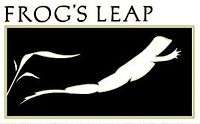Frog's Leap Winery
| Frog's Leap | |
|---|---|
 | |
| Location | Rutherford, California, USA |
| Coordinates | 38°28′25″N 122°24′04″W / 38.4737°N 122.401°WCoordinates: 38°28′25″N 122°24′04″W / 38.4737°N 122.401°W |
| Appellation | Rutherford AVA |
| Founded | 1981[1] |
| First vintage | 1981 |
| Key people |
John Williams, owner & winemaker Paula Moschetti, winemaker Jonah Beer, general manager |
| Cases/yr | 60,000[2] |
| Known for |
Sauvignon Blanc[3] Cabernet Sauvignon[4] |
| Varietals | Sauvignon blanc, Chardonnay, Zinfandel, Petite Sirah, Merlot, Cabernet Sauvignon, Cabernet Franc, Valdiguié, Riesling |
| Distribution | national |
| Tasting | by appointment |
| Website | www.frogsleap.com |
Frog's Leap Winery is a California wine producer that operates from Rutherford. It was founded in 1981 on a spot along Mills Creek known as Frog Farm.[5] Frog's Leap Winery was established by John Williams and Larry Turley.[6]
In addition to their accolades for their wines, Frog's Leap is also noted for its humorous approach to winemaking,[1] down to their "Ribbit" corks.[7] The winery got its name by combining "Frog Farm" (where its first wines were made) with "Stag's Leap"[6] (where John Williams had his first winemaking job).[8]
History
John Williams and Larry Turley formed Frog's Leap in 1981 at the site of the historic Adamson Winery, producing 700 cases of sauvignon blanc.[6] When they started, Turley was a doctor and Williams was a winemaker at Spring Mountain Vineyard.[9] They took the winery into organic farming, and made it the first Napa winery with certified organically grown grapes.[2] They built up the winery in Saint Helena, California[1] together until 1994, when John Williams took Frog's Leap to the Red Barn Ranch in Rutherford, California and Larry Turley established what is now Turley Wine Cellars.[10] In 2004, Sunlight Electric met with Frog's Leap discussing how the winery was spending around $50,000 annually on electricity. On February 9, 2005, the photovolatic system went live over Frog's Leap's leeching fields. With the system's annual output of 260,000 kilowatt-hours (9.4×1011 J), it produces about 85% of the site's energy usage.[11]
Winemaking
Frog's Leap features organically grown grapes and dry-farmed vineyards.[12] Owner John Williams believes dry-farming results in stronger, healthier vines.[13]
Frog's Leap engages in other green practices as well. They were one of the first wineries to use solar power to run their entire operation.[14][11] The winery also includes the use of compost and cover crops to organically enrich the soil, as well as dry farming to conserve water and reduce soil erosion.[11]
Wines
Frog's Leap used to make a wine known as "Leapfrögmilch"[6] (a pun on Liebfraumilch), but after an incidence of noble rot in 2006, they replaced it with "Frögbeerenauslese"[12] (a pun on Trockenbeerenauslese).
References
- 1 2 3 Tim Atkin (1991-02-02). "Wine: Time's fun when you're having flies". The Guardian.
- 1 2 Michael V. Russo (2008). Environmental Management. SAGE. p. 266. ISBN 1-4129-5849-0.
- ↑ "Tony Fletcher's iJamming! Featured Wine: Frog's Leap Sauvignon Blanc". Retrieved 2009-07-02.
- ↑ Eric Asimov (2008-08-20). "In Napa, some wineries choose the old route". The New York Times. p. F1. Retrieved 2009-07-04.
- ↑ "Frog's Leap Winery". Atlas of Wineries.
- 1 2 3 4 David Shaw (2003-01-08). "Organic for a different reason". Los Angeles Times. p. Food 6. Retrieved 2009-07-04.
- ↑ Kevin Zraly (2006). Windows on the World Complete Wine Course. Sterling Publishing Company. p. 257. ISBN 1-4027-3928-1., although the book incorrectly spells it "Ribit"
- ↑ "Harvest Restaurant - Special Events". Retrieved 2009-07-03.
- ↑ Terry Robards (1982-07-04). "Frog's Leap: A prince of a wine". The New York Times. p. 34.
- ↑ L. Pierce Carson (1994-01-24). "Partners leap in new directions". Napa Valley Register.
- 1 2 3 "Case Study: Frog's Leap Winery, Rutherford, CA". Sunlight Electric. Retrieved 2009-07-02.
- 1 2 Clive Platman (2009-05-09). "All in the best possible taste". Birmingham Post. p. 4.
- ↑ James Conaway (2008-08-27). "The time is ripe for Napa's organic grapes". The Washington Post. p. F5. Retrieved 2009-07-04.
- ↑
- Tom Bender (2008-02-27). "Jump to Frog's Leap in Napa". The Modesto Bee. p. E2.
- Committee on Ways and Means, Subcommitte on Select Revenue Measures, Congree, House (2005). Tax Credits for Electricity Production from Renewable Sources. DIANE Publishing Company. p. 56. ISBN 1-4223-3419-8.
External links
